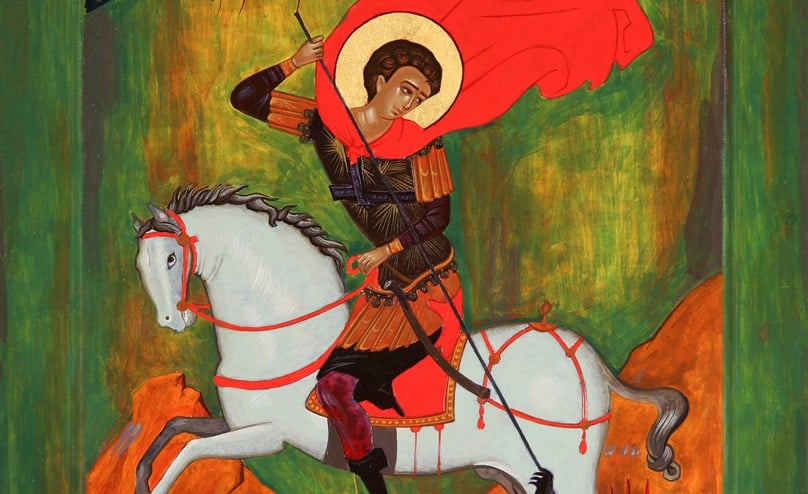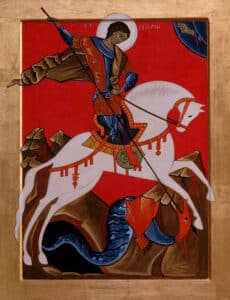
The battle over the last dragon has inspired iconographers and artists for centuries and galvanised Michael Galovic, who has spent more than a year on his passion project of completing 12 icons dedicated to the theme.
Opening in Hunters Hill on 28 April Galovic says the week-long exhibition will be the first of its kind held in the country and will also include an account of the saint’s influence and veneration in the eastern and western churches by Kerrie Magee, Galovic’s friend and student.
“The dynamism of the whole scene is exciting as with no other individual saint,” Galovic said.
“No wonder that some modern artists made works inspired by this particular icon and not some other static one, with Vasily Kandinsky being the best example.
“Their dynamism from an aesthetic point of view also intrigued and attracted me, even apart from the spiritual, theological and mythological aspects.
“I would like to paint some contemporary versions, but first I wanted to demonstrate the endless inventiveness, creativity and beauty of medieval iconographers’ work.
“Icons can be very exciting and dynamic, they are also very difficult to make.”
For his study of the saint thought to be an early Christian martyr during the reign of the Roman emperor Diocletian, Galovic drew upon traditional Greek and Slavic iconography from the 13th to 15th centuries.
Magee said the earliest references to St George emerged in the 4th century but depictions of him defeating a dragon began in the early 11th century.
“It’s always about the power to fight against evil, whether that’s religious persecution or mythical dragons, and to stand your ground, irrespective of the cost,” she said.

“It’s one of the most strongly striking motifs that comes through all of Orthodox art and there has been continuous growth and varying iterations of it. Each of them strikes a chord.
“I’ve been fascinated by icons since I was about 15 but the St George ones are particularly universal in their appeal and these ones by Michael are beautifully done.”
From his central coast home the 74-year-old’s work appears in churches and religious institutions throughout Australia and overseas, including an icon of St Benedict recently installed in a Benedictine monastery in France and a depiction of the angel at Christ’s empty tomb at the Marist Centre in Sydney.
He hopes to paint contemporary versions of St George in the future but enjoyed learning about the late medieval icons themselves and painstakingly replicated well-known masterpieces, although he says there is “no such thing as a 100 per cent copy.”
“I was fascinated how in the so-called convention the elements in these icons are the same, such as a horse, a dragon, a spear, a landscape with a lake and so on, but when you look through the medieval icons you see that each one is a little jewel of inventiveness and creativity,” Galovic said.
“Spiritually we have a unique situation with three realms or planes—the superior or higher one represented by God’s hand at the top, this ‘earthly level or plane’ where the scene takes place, and the lower level featuring either a dark cave or a lake alluding to the underworld, the darkness and chaos before the light of the revelation.
“So, it is a multilayered composition and a highly stimulating one.”
Interpretations also vary although St George is always a representative of Christianity, often depicted with a cross at the top of his spear.
“Sometimes the dragon stands for earlier heathen or polytheistic traditions which now recognise a new master in the Christian religion and so surrenders serenely, rather than fighting back as it does in western depictions,” Galovic explained.
“The presence of a king and the queen are deemed to be the Emperor Constantine and his mother Helen, while the princess is a symbol of a new church or religion which St George is defending.”
The exhibition will also include a number of contemporary artworks from Galovic’s body of work featuring Uluru and is unlikely to be repeated, as all works are for sale.
All Saints’ Anglican Church in Hunters Hill will host George vs the Dragon, opening at 4-6pm on 28 April.
It will be open each day from 10am-2pm from 29 April-4 May and 5pm-7pm on 3 May, with Galovic in residence throughout. Entry is free.
